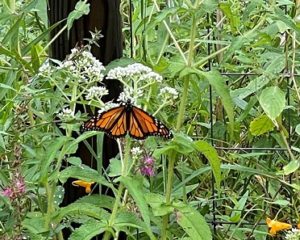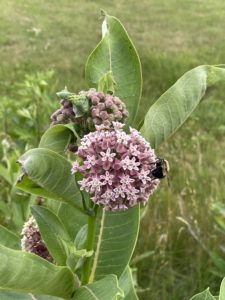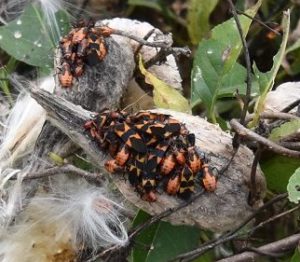Hello Fellow Readers, Over the weekend, I met my writing buddy Drew Cusano at Merrill Creek Reservoir and Environmental Preserve in Harmony Township, NJ— a place I never explored. I thought this week’s chat would be about the history and ecological initiatives of the reservoir (link below), but what became fascinating to me were the clusters of milkweed bugs all over the puffy milkweed seeds bursting from their pods with silky feathers ready for flight. (Mother Nature’s seed dispersal strategies can be so clever.)
With my big girl camera in hand, I traipsed through the field to take photos of the orangey-red bugs with black markings, new to me.
Only a Few Insects can eat Milkweed.
The milky white substance that gives the milkweed its common name contains a toxic chemical (cardiac glycosides). And so, only a few insects besides monarch butterfly caterpillars have adapted to ingesting it. There are milkweed tussock caterpillars, oleander aphids, long-horned milkweed beetles, and, as it turns out, large and small milkweed bugs.
Interestingly, the bugs, beetles, and monarchs that eat milkweed have in common an orange-reddish color, a warning flag that they are toxic to eat, serving as a defense mechanism to predators. The blossom of milkweed isn’t poisonous, though; hence other pollinators enjoy the beautiful globe-shaped puffs of pink.
Milkweed Bugs may seem icky, but they are harmless.
We came upon large milkweed bugs (Oncopeltus fasciatus), about a half to three-quarter inches long. The good news is they are short-lived, only about a month, and do not harm the plant, though you can lessen the population by removing plant debris where they overwinter.
And while you can spray dormant oil to kill the suckers on contact, there’s no need. Yes, milkweed bugs will sometimes feed on the young larvae of monarch butterflies. But it’s best to consider it part of the cycle of life and let them be. Besides, they don’t bite or sting.
Monarchs need Milkweed
 Milkweed is the only plant on which monarch butterfly caterpillars (Danaus plexippus) feed. Of course, monarch butterflies enjoy the nectar of other plants, but their larvae, the caterpillars, must feed on milkweed.
Milkweed is the only plant on which monarch butterfly caterpillars (Danaus plexippus) feed. Of course, monarch butterflies enjoy the nectar of other plants, but their larvae, the caterpillars, must feed on milkweed.
Thankfully, awareness of the decline of monarchs is well known, and many are planting milkweed. There are dozens of species of the native wildflower growing in every part of North America, but it’s best to plant the species native to the area.
In our neck of the woods, as is most regions, common milkweed (Asclepias syriaca) is often seen in fields and along roadsides. There’s also swamp milkweed (A. incarnata) and butterfly weed (A. tuberosa), more ornamental and sold at garden centers.
 When to Plant Milkweed
When to Plant Milkweed
The time to dig in new plants in early spring after the risk of frost. Choose open areas with full sun where milkweed does best. However, late fall is an ideal time to plant milkweed seeds. That way, Mother Nature will take care of seed stratification over winter. Like most wildflowers, milkweed needs cold and damp conditions to signal seeds to germinate once the soil warms. Mother Nature can be so clever.
Garden Dilemmas? AskMaryStone@gmail.com (and your favorite Podcast App.)
Link to a previous column Deer Resistant Butterfly Plants
About Merrill Creek Reservoir and Environmental Preserve
Links to more about the Milkweeds mentioned: Common Milkweed (Asclepias syriaca), Swamp Milkweed (A. incarnate), and Butterfly Weed (A. tuberosa)




